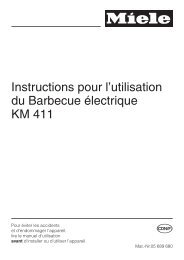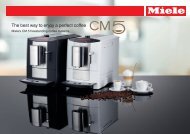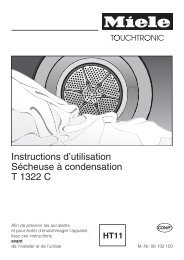Safety Data Sheet - Miele
Safety Data Sheet - Miele
Safety Data Sheet - Miele
You also want an ePaper? Increase the reach of your titles
YUMPU automatically turns print PDFs into web optimized ePapers that Google loves.
<strong>Safety</strong> <strong>Data</strong> <strong>Sheet</strong><br />
according to WHMIS<br />
neodisher 30<br />
Print date: 11.06.2012 Revision date: 16.08.2010<br />
Page 1 of 5<br />
SECTION 1: Identification of the substance/mixture and of the company/undertaking<br />
Product identifier<br />
neodisher 30<br />
Relevant identified uses of the substance or mixture and uses advised against<br />
Use of the substance/mixture<br />
Cleaning agent.<br />
Details of the supplier of the safety data sheet<br />
Company name:<br />
Street:<br />
Place:<br />
Chemische Fabrik Dr. Weigert GmbH & Co. KG<br />
Mühlenhagen 85<br />
D-20539 Hamburg<br />
Telephone: +49 40 789 60 0 Telefax: +49 40 789 60 200<br />
Internet:<br />
Responsible Department:<br />
Emergency telephone:<br />
SECTION 2: Hazards identification<br />
Classification of the substance or mixture<br />
www.drweigert.de<br />
sida@drweigert.de<br />
USA: Emergency Tel. No. 1-800 535 5053 (tollfree), from outside USA: +001 352<br />
323 3500 or a National Poison Contral centre<br />
Indications of danger : Corrosive<br />
R-phrases:<br />
Contact with acids liberates toxic gas.<br />
Causes burns.<br />
Irritating to respiratory system.<br />
Harmful to aquatic organisms, may cause long-term adverse effects in the aquatic environment.<br />
SECTION 3: Composition/information on ingredients<br />
Mixtures<br />
Hazardous components<br />
CAS No.<br />
Chemical name<br />
Quantity<br />
6834-92-0 disodium metasilicate 30 - 35 %<br />
497-19-8 sodium carbonate 30 - 35 %<br />
2893-78-9 troclosene sodium 1 - 5 %<br />
SECTION 4: First aid measures<br />
Description of first aid measures<br />
After inhalation<br />
not applicable<br />
After contact with skin<br />
After contact with skin, wash immediately with: Water.<br />
After contact with eyes<br />
If product gets into the eye, keep e4yelid open and rinse immediately with large quantities of water, for<br />
at least 5 minutes. Subsequently consult an opthalmologist.<br />
Revision no.: 1,02 CDN - EN R_GH-Code 633_25 461
<strong>Safety</strong> <strong>Data</strong> <strong>Sheet</strong><br />
according to WHMIS<br />
neodisher 30<br />
Print date: 11.06.2012 Revision date: 16.08.2010<br />
Page 2 of 5<br />
After ingestion<br />
Rinse mouth immediately and drink large quantities of water.<br />
Indication of any immediate medical attention and special treatment needed<br />
Treat symptomatically.<br />
SECTION 5: Firefighting measures<br />
Extinguishing media<br />
Suitable extinguishing media<br />
Water fog. Water. Foam.<br />
Extinguishing media which must not be used for safety reasons<br />
none / none<br />
Special hazards arising from the substance or mixture<br />
none / none<br />
Advice for firefighters<br />
none / none<br />
SECTION 6: Accidental release measures<br />
Personal precautions, protective equipment and emergency procedures<br />
Wear personal protection equipment.<br />
Environmental precautions<br />
Do not empty into drains or the aquatic environment.<br />
Methods and material for containment and cleaning up<br />
Remove mechanically, placing in appropriate containers for disposal.<br />
SECTION 7: Handling and storage<br />
Precautions for safe handling<br />
Advice on safe handling<br />
All working processes must always be organised so that the following can be ruled out: skin contact.<br />
Eye contact.<br />
Conditions for safe storage, including any incompatibilities<br />
Requirements for storage rooms and vessels<br />
No special technical protective measures are necessary.<br />
Further information on storage conditions<br />
Protect against: moisture.<br />
Storageclass (D):<br />
SECTION 8: Exposure controls/personal protection<br />
Control parameters<br />
Exposure controls<br />
Protective and hygiene measures<br />
Do not eat, drink, smoke or sneeze at the workplace.<br />
8B<br />
Hand protection<br />
Type of chemical protective gloves to choose depends on the concentration and quantity of dangerous<br />
substances as well as on work place specifications. When handling chemical substances, chemical<br />
protective gloves must be worn with CE label including a four digit code. In case of reutilization, clean<br />
gloves before taking off and store in well-aired place.<br />
Revision no.: 1,02 CDN - EN R_GH-Code 633_25 461
<strong>Safety</strong> <strong>Data</strong> <strong>Sheet</strong><br />
according to WHMIS<br />
neodisher 30<br />
Print date: 11.06.2012 Revision date: 16.08.2010<br />
Page 3 of 5<br />
Duration of wearing with occasional contact (splashes): Duration of wearing with permanent contact:<br />
Suitable material:<br />
Butyl rubber.FKM (Fluoroelastomer (Viton)). NBR (Nitrile rubber). CR (polychloroprenes, Chloroprene<br />
rubber). NR (Natural rubber (Caoutchouc), Natural latex). PVC (Polyvinyl chloride).<br />
In the cases of special applications, it is recommended to check the chemical resistance with the<br />
manufacturer of the gloves.<br />
Eye protection<br />
Suitable eye protection: Framed glasses. Tightly sealed safety glasses. EN 166<br />
Skin protection<br />
Take off immediately all contaminated clothing<br />
SECTION 9: Physical and chemical properties<br />
Information on basic physical and chemical properties<br />
Physical state:<br />
Colour:<br />
Odour:<br />
solid<br />
white<br />
characteristic<br />
pH-Value: ca. 13 (10 %)<br />
Changes in the physical state<br />
Flash point:<br />
not applicable<br />
Oxidizing properties<br />
none / none<br />
Water solubility: easily soluble.<br />
SECTION 10: Stability and reactivity<br />
Test method<br />
Conditions to avoid<br />
Keep the packing dry and well sealed to prevent contamination and absorbtion of dampness.<br />
Incompatible materials<br />
Reacts with : acid, concentrated.<br />
Hazardous decomposition products<br />
Contact with acids liberates toxic gas.<br />
SECTION 11: Toxicological information<br />
Information on toxicological effects<br />
Acute toxicity<br />
Acute toxicity, oral LD50: calculated. mg/kg bw: > 4000<br />
Irritation and corrosivity<br />
corrosive.<br />
Further information<br />
Acute toxicity, irritation of the skin and mucous mebrane, and mutagenic potential of the preparation<br />
were assessed by the manufacturer on the basis of the data available on the main components.<br />
Information gaps exist on some of the main individual components. However, according to the<br />
experience of the manufacturer, no dangers above and beyond those on the product label are to be<br />
expected.The classification was undertaken in accordance with the calculation method governed by the<br />
Preparations Directive (1999/45/EC).<br />
SECTION 12: Ecological information<br />
Revision no.: 1,02 CDN - EN R_GH-Code 633_25 461
<strong>Safety</strong> <strong>Data</strong> <strong>Sheet</strong><br />
according to WHMIS<br />
neodisher 30<br />
Print date: 11.06.2012 Revision date: 16.08.2010<br />
Page 4 of 5<br />
Other adverse effects<br />
due to the alkaline character of the product, usually, it has to be neutralized before contaminated<br />
effluents are introduced into the waste water treatment system.<br />
Further information<br />
The evaluation was carried out according to the calculation method of the Preparations Directive.<br />
SECTION 13: Disposal considerations<br />
Waste treatment methods<br />
Advice on disposal<br />
Consult the local waste disposal expert about waste disposal. According to EAKV, allocation of waste<br />
identity numbers/waste descriptions must be carried out in a specific way for every industry and<br />
process.<br />
Contaminated packaging<br />
Completely emptied packings can be re-cycled.<br />
Waste disposal according to official state regulations.<br />
SECTION 14: Transport information<br />
Canadian TDG<br />
Proper shipping name<br />
DISODIUM TRIOXOSILICATE<br />
UN/ID number:<br />
Hazard classes:8<br />
Packing group: III<br />
Hazard label: 8<br />
Limited quantity: 5<br />
Land transport (ADR/RID)<br />
UN number:<br />
UN proper shipping name:<br />
Transport hazard class(es):<br />
Packing group:<br />
Hazard label:<br />
3253<br />
Classification Code: C6<br />
Limited quantity: LQ24<br />
Hazard-no.:<br />
80<br />
Other applicable information (land transport)<br />
E1<br />
: 3<br />
: E<br />
Marine transport<br />
UN number:<br />
UN proper shipping name:<br />
Transport hazard class(es):<br />
UN3253<br />
DISODIUM TRIOXOSILICATE, Gemisch<br />
8<br />
III<br />
8<br />
3253<br />
DISODIUM TRIOXOSILICATE, mixture<br />
8<br />
Revision no.: 1,02 CDN - EN R_GH-Code 633_25 461
<strong>Safety</strong> <strong>Data</strong> <strong>Sheet</strong><br />
according to WHMIS<br />
neodisher 30<br />
Print date: 11.06.2012 Revision date: 16.08.2010<br />
Page 5 of 5<br />
Packing group:<br />
Hazard label:<br />
Marine pollutant:<br />
no<br />
Limited quantity: 5 kg<br />
EmS:<br />
F-A, S-B<br />
Other applicable information (marine transport)<br />
Special provisions: -<br />
SECTION 15: Regulatory information<br />
Canadian regulations<br />
III<br />
8<br />
This product has been classified according to the hazard criteria of the CPR and the MSDS contains all the<br />
information required by the CPR.<br />
WHMIS classification<br />
Class E Corrosive material<br />
SECTION 16: Other information<br />
(The data for the hazardous ingredients were taken respectively from the last version of the sub-contractor's safety<br />
data sheet.)<br />
Revision no.: 1,02 CDN - EN R_GH-Code 633_25 461


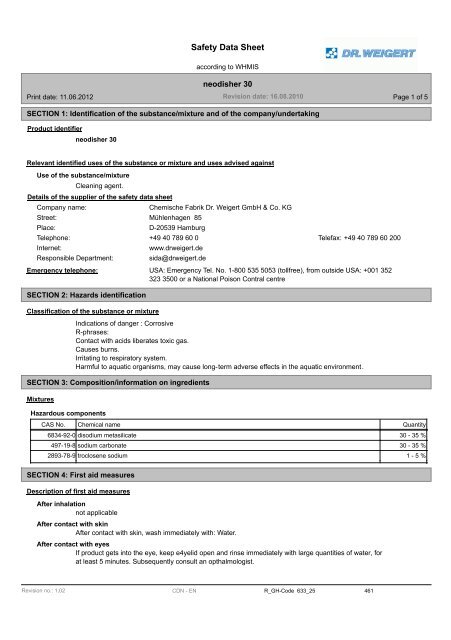

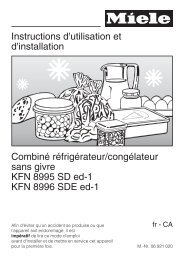
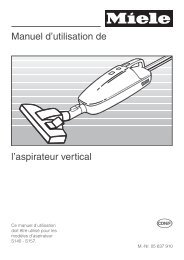
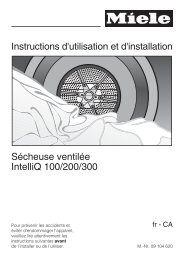
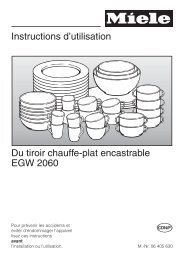
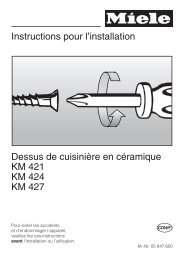
![Dimensions de produit [PDF] - Miele](https://img.yumpu.com/16662205/1/190x245/dimensions-de-produit-pdf-miele.jpg?quality=85)
